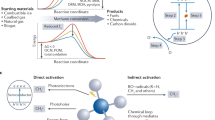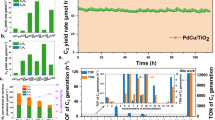Abstract
Dry reforming of methane is one of the key reactions to exploit natural gas feedstocks by their catalytic conversion to synthesis gas (CH4 + CO2 → 2H2 + 2CO), which is used in the production of transportable liquid fuel. However, this reaction suffers from thermodynamic conversion limits and high thermal energy requirements. Herein we report that a SrTiO3-supported rhodium (Rh/STO) catalyst efficiently promotes methane reforming under ultraviolet light irradiation without heat supply at low temperatures, which cannot be achieved by conventional thermal catalysis. The photoexcited holes and electrons are used for CH4 oxidation over STO and CO2 reduction over rhodium, respectively. Isotope analysis clarified that the lattice oxygens (O2−) act as mediator to drive dry reforming of methane. The materials design of Rh/STO can be extended in principle to diverse uphill reactions that utilize photon energy to obtain valued products from different carbon resources.
This is a preview of subscription content, access via your institution
Access options
Access Nature and 54 other Nature Portfolio journals
Get Nature+, our best-value online-access subscription
$29.99 / 30 days
cancel any time
Subscribe to this journal
Receive 12 digital issues and online access to articles
$119.00 per year
only $9.92 per issue
Buy this article
- Purchase on Springer Link
- Instant access to full article PDF
Prices may be subject to local taxes which are calculated during checkout





Similar content being viewed by others
Data availability
The data that support the findings of this study are available from the Article and Supplementary Information, or from the corresponding authors on reasonable request.
References
Kato, H. & Kudo, A. Water splitting into H2 and O2 on alkali tantalate photocatalysts ATaO3 (A = Li, Na, and K). J. Phys. Chem. B 105, 4285–4292 (2001).
Sekizawa, K., Maeda, K., Domen, K., Koike, K. & Ishitani, O. Artificial Z-scheme constructed with a supramolecular metal complex and semiconductor for the photocatalytic reduction of CO2. J. Am. Chem. Soc. 135, 4596–4599 (2013).
Bahnemann, D. Photocatalytic water treatment: solar energy applications. Sol. Energy 77, 445–459 (2004).
Hsu, H.-C. et al. Graphene oxide as a promising photocatalyst for CO2 to methanol conversion. Nanoscale 5, 262–268 (2013).
Yuliati, L., Itoh, H. & Yoshida, H. Photocatalytic conversion of methane and carbon dioxide over gallium oxide. Chem. Phys. Lett. 452, 178–182 (2008).
Yuliati, L. & Yoshida, H. Photocatalytic conversion of methane. Chem. Soc. Rev. 37, 1592–1602 (2008).
Shimura, K. et al. Photocatalytic steam reforming of methane over sodium tantalate. J. Phys. Chem. C 114, 3493–3503 (2010).
Han, B., Wei, W., Chang, L., Cheng, P. & Hu, Y. H. Efficient visible light photocatalytic CO2 reforming of CH4. ACS Catal. 6, 494–497 (2015).
Wibowo, S. et al. Photo-assisted dry reforming of methane over strontium titanate. Chem. Lett. 47, 935–937 (2018).
Konta, R., Ishii, T., Kato, H. & Kudo, A. Photocatalytic activities of noble metal ion doped SrTiO3 under visible light irradiation. J. Phys. Chem. B 108, 8992–8995 (2004).
Shoji, S., Yamaguchi, A., Sakai, E. & Miyauchi, M. Strontium titanate based artificial leaf loaded with reduction and oxidation cocatalysts for selective CO2 reduction using water as an electron donor. ACS Appl. Mater. Interfaces 9, 20613–20619 (2017).
Fujishima, A. & Honda, K. Electrochemical photolysis of water at a semiconductor electrode. Nature 238, 37–38 (1972).
Sayama, K., Mukasa, K., Abe, R., Abe, Y. & Arakawa, H. Stoichiometric water splitting into H2 and O2 using a mixture of two different photocatalysts and an IO3 −/I− shuttle redox mediator under visible light irradiation. Chem. Commun. https://doi.org/10.1039/B107673F (2001).
Osaki, T. & Mori, T. Role of potassium in carbon-free CO2 reforming of methane on K-promoted Ni/Al2O3 catalysts. J. Catal. 204, 89–97 (2001).
Alipour, Z., Rezaei, M. & Meshkani, F. Effect of alkaline earth promoters (MgO, CaO, and BaO) on the activity and coke formation of Ni catalysts supported on nanocrystalline Al2O3 in dry reforming of methane. J. Ind. Eng. Chem. 20, 2858–2863 (2014).
Miyauchi, M., Nakajima, A., Watanabe, T. & Hashimoto, K. Photocatalysis and photoinduced hydrophilicity of various metal oxide thin films. Chem. Mater. 14, 2812–2816 (2002).
Gattrell, M., Gupta, N. & Co, A. A review of the aqueous electrochemical reduction of CO2 to hydrocarbons at copper. J. Electroanal. Chem. 594, 1–19 (2006).
Shoji, S. et al. Topologically immobilized catalysis centre for long-term stable carbon dioxide reforming of methane. Chem. Sci. 10, 3701–3705 (2019).
Nosaka, Y., Takahashi, S., Mitani, Y., Qiu, X. & Miyauchi, M. Reaction mechanism of visible-light responsive Cu(ii)-grafted Mo-doped SrTiO3 photocatalyst studied by means of ESR spectroscopy and chemiluminescence photometry. Appl. Catal. B 111, 636–640 (2012).
Hirakawa, T., Nakaoka, Y., Nishino, J. & Nosaka, Y. Primary passages for various TiO2 photocatalysts studied by means of luminol chemiluminescent probe. J. Phys. Chem. B 103, 4399–4403 (1999).
Chiesa, M., Paganini, M. C., Livraghi, S. & Giamello, E. Charge trapping in TiO2 polymorphs as seen by electron paramagnetic resonance spectroscopy. Phys. Chem. Chem. Phys. 15, 9435–9447 (2013).
Maeda, K. et al. Noble-metal/Cr2O3 core/shell nanoparticles as a cocatalyst for photocatalytic overall water splitting. Angew. Chem. 118, 7970–7973 (2006).
Kazuma, E. & Tatsuma, T. In situ nanoimaging of photoinduced charge separation at the plasmonic Au nanoparticle‐TiO2 interface. Adv. Mater. Interfaces 1, 1400066 (2014).
Watanabe, R. et al. Role of alkali metal in a highly active Pd/alkali/Fe2O3 catalyst for water gas shift reaction. Appl. Catal. A 457, 1–11 (2013).
Song, H. et al. Visible-light-mediated methane activation for steam methane reforming under mild conditions: a case study of Rh/TiO2 catalysts. ACS Catal. 8, 7556–7565 (2018).
Jiang, H. et al. Photocatalytic partial oxidation of methane on palladium-loaded strontium tantalate. Sol. RRL 3, 1900076 (2019).
Zhu, J., van Ommen, J. G., Bouwmeester, H. J. M. & Lefferts, L. Activation of O2 and CH4 on yttrium-stabilized zirconia for the partial oxidation of methane to synthesis gas. J. Catal. 233, 434–441 (2005).
Enger, B. C., Lødeng, R. & Holmen, A. A review of catalytic partial oxidation of methane to synthesis gas with emphasis on reaction mechanisms over transition metal catalysts. Appl. Catal. A 346, 1–27 (2008).
Miyauchi, M., Takashio, M. & Tobimatsu, H. Photocatalytic activity of SrTiO3 codoped with nitrogen and lanthanum under visible light illumination. Langmuir 20, 232–236 (2004).
Acknowledgements
This research was supported by a grant from the Japan Society for the Promotion of Science DC1 and Japan Science and Technology Agency (JST) CREST (grant no. JPMJCR15P1). We thank R. Ota and Y. Otsuka at the Center for Advanced Materials Analysis of the Tokyo Institute of Technology for helping with the inductively coupled plasma measurement.
Author information
Authors and Affiliations
Contributions
S.S. conducted the experimental studies and wrote the paper. X.P. evaluated catalytic properties. A.Y. contributed to the experimental design and gave deep insight into photocatalytic reaction. R.W. and C.F. gave great advice on isotope trace experiment. Y.C. investigated the photocatalytic properties of various semiconductors. T.Y. and S.M. contributed to high magnification TEM observation. M.W.Y. and S.I. conducted KPFM analysis. T.F. contributed TEM analysis and helped manuscript organization. H.A. contributed to the X-ray photoelectron spectroscopy analysis and gave great advice for paper organization. M.M conceived this project and wrote the paper. All authors discussed the results and commented on the manuscript.
Corresponding authors
Ethics declarations
Competing interests
The authors declare no competing interests.
Additional information
Publisher’s note Springer Nature remains neutral with regard to jurisdictional claims in published maps and institutional affiliations.
Supplementary information
Supplementary Information
Supplementary Methods, Figs. 1–10.
Rights and permissions
About this article
Cite this article
Shoji, S., Peng, X., Yamaguchi, A. et al. Photocatalytic uphill conversion of natural gas beyond the limitation of thermal reaction systems. Nat Catal 3, 148–153 (2020). https://doi.org/10.1038/s41929-019-0419-z
Received:
Accepted:
Published:
Issue Date:
DOI: https://doi.org/10.1038/s41929-019-0419-z
This article is cited by
-
Light alters reaction pathways
Nature Energy (2024)
-
Photocatalytic ethylene production by oxidative dehydrogenation of ethane with dioxygen on ZnO-supported PdZn intermetallic nanoparticles
Nature Communications (2024)
-
Enhanced hybrid photocatalytic dry reforming using a phosphated Ni-CeO2 nanorod heterostructure
Nature Communications (2023)
-
Balancing elementary steps enables coke-free dry reforming of methane
Nature Communications (2023)
-
Conjugated cross-linked phosphine as broadband light or sunlight-driven photocatalyst for large-scale atom transfer radical polymerization
Nature Communications (2023)



